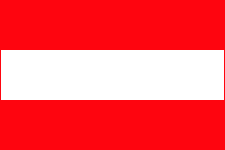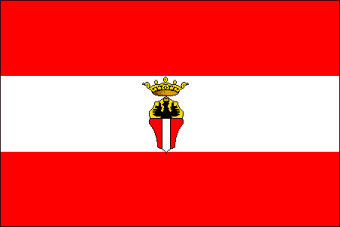
by Francesco Murialdo

Last modified: 2004-12-29 by dov gutterman
Keywords: liguria | savona |
Links: FOTW homepage |
search |
disclaimer and copyright |
write us |
mirrors
See also:
Savona officially adopted the city flag on may 6, 1994 when
some changes in the town Statute came into force (30 days after
they appeared on the Official Bulletin of Regione Liguria, april
6, 1994).
Art. 4 of the Statute read: "The flag (named
"vessillo") of the Commune of Savona consists of a
cloth with three horizontal stripes of equal size, in colours
red, white and red"
Francesco Murialdo

by Roberto Breschi from CISV
Nevertheless a few actual flags show the city coat
of arms in the middle of the white stripe; namely on
town-hall when the town council is in session and in front of the
war memorial . Width to lenght ratio is 2:3 (like Italian flag).
However these flags (both with and without the coat of arms) were
already widely in use in the century from middle 1800s' to middle
1900s'.
Francesco Murialdo
In the second half of 20th century a vertical striped flag
came up by the side of the horizontal striped one. A debate arose
in Savona between the supporters of the two patterns: vertical
stripes refer to the more ancient medieval flag; horizontal
stripes are in continuity with the nineteenth-century tradition.
The matter was settled in 1994 by the official description in the
new Statute.
Francesco Murialdo
Savona formally had been a free state-city since april 10, 1191 when the Marquis of Savona waived his last rights in favour of the Commune, up to october 29, 1528 after the definitive surrender in front of the more powerful neighbour Genoa. Indeed the full independence of Savona had been often restricted by the treaties that Genoa imposed and by foreign protectorates ('Signorie') e.g. France, Milan, the same Genoa, etc. This fact did not bring about a change in the flag; the arms of the rulers however were depicted on towers and engraved on coins.
In those times (mainly centuries 13th to 15th) many sources as frescoes, bas-reliefs, portolanos (the medieval charts) show the red-white-red flag with stripes almost always set vertically, white narrower as the heraldic pale in the arms.
Sometimes surmounted with the "Chief of the Empire" i.e. a black eagle on a golden field.
Iconographic documentation of the same era sometimes shows on city military fortifications (castles, towers ...) a flag representing the sole Imperial standard, i.e. black eagle on gold, perhaps to emphasize the loyalty of the town to the Emperors. Furthermore the eagle had been the pre-eminent figure in Savonese coinage.
In 16th century the four wards of the town had its own gonfalon with images respectively of Saint Peter, Saint John, the Virgin, and (probably) Saint Andrew.
Sources:
- Les portulans - Cartes marines du XIIIe au XVIIe siécle (in
English: The portolanos - Maritime charts from 13th to
17th century) by Monique De La Ronciére, Michel Mollat du
Jourdin, Office du Livre: Fribourg (Switzerland) 1984.
- Un cartografo a Savona nel primo Quattrocento by Corradino Astengo, Sabazia (nuova serie) number 2 (1987) pages: 6-8.
- Iconografia e documenti sulla bandiera di Savona (Iconography and documents about the flag of Savona [Italy]) by Francesco Murialdo, Studi in omaggio a Carlo Russo nel suo settantacinquesimo compleanno (1995) pages 269-283
- I vessilli degli antichi quartieri savonesi (The flags of
the ancient Savona's wards) by Carlo Varaldo, Sabazia 2 (1982)
pages 15-16
Francesco Murialdo
savon.gif)
by Filippo Noceti, 8 June 2001
This is the symbol of another important ligurian city, Savona.
Ancient ligurian centre "Savo" has been allied whith
Annibal in punic wars, savo ever avails again Genoa that was
allied whith Rome. After the moorish incursions in middleages
Savona became the principal town of the marquisade of Savona (and
after of Carretto), born from the division of the Marquisade of
Monferrato. In XV century Genoa conquered definitively Savona.
Filippo Noceti, 8 June 2001